Financial Reporting: Performance and Position of The Unite Group Plc
VerifiedAdded on 2023/01/19
|10
|2645
|1
AI Summary
This article discusses the performance and position of The Unite Group Plc based on ratio analysis. It also explores the change in lease accounting from IAS 17 to IFRS 16.
Contribute Materials
Your contribution can guide someone’s learning journey. Share your
documents today.
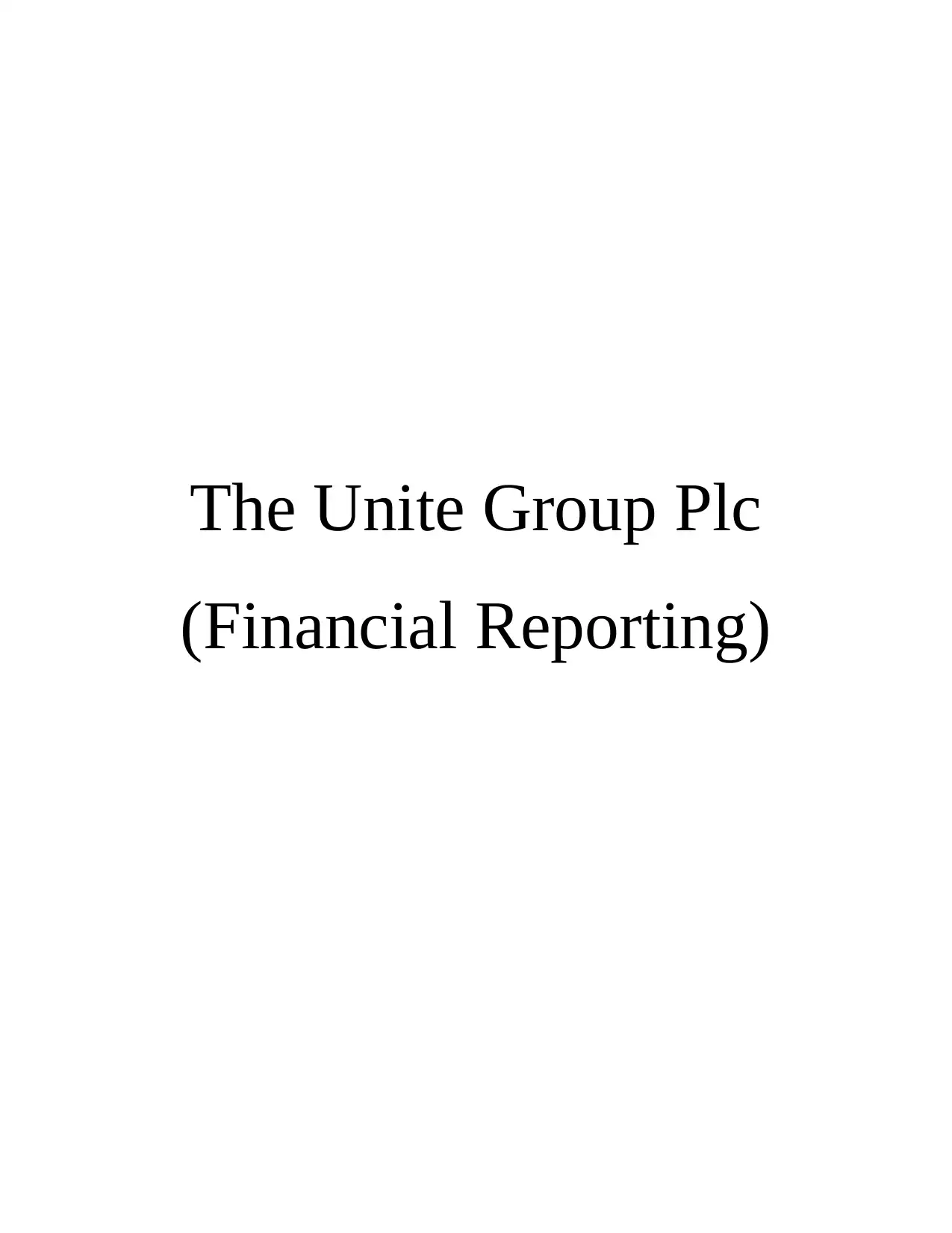
The Unite Group Plc
(Financial Reporting)
(Financial Reporting)
Secure Best Marks with AI Grader
Need help grading? Try our AI Grader for instant feedback on your assignments.
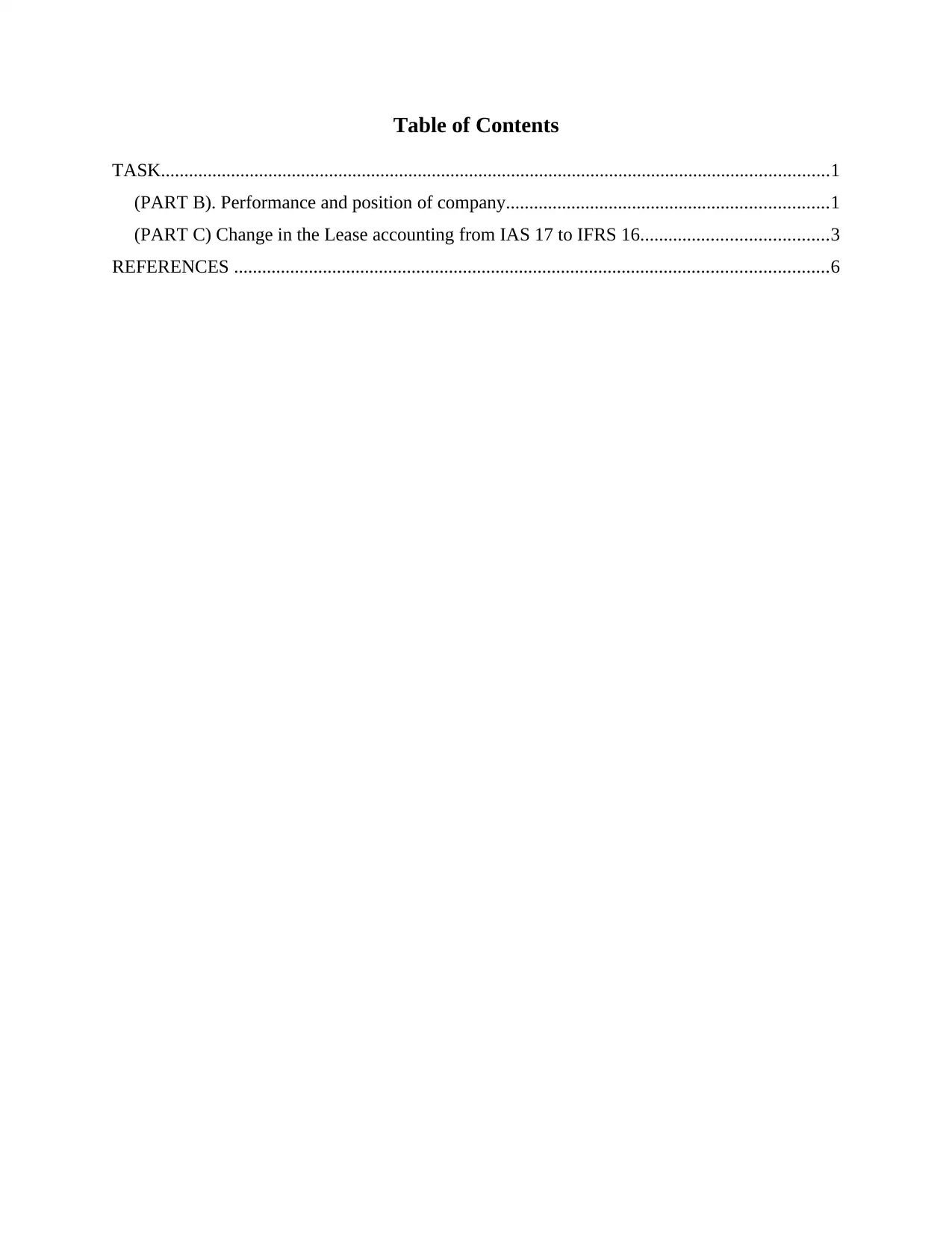
Table of Contents
TASK...............................................................................................................................................1
(PART B). Performance and position of company.....................................................................1
(PART C) Change in the Lease accounting from IAS 17 to IFRS 16........................................3
REFERENCES ...............................................................................................................................6
TASK...............................................................................................................................................1
(PART B). Performance and position of company.....................................................................1
(PART C) Change in the Lease accounting from IAS 17 to IFRS 16........................................3
REFERENCES ...............................................................................................................................6

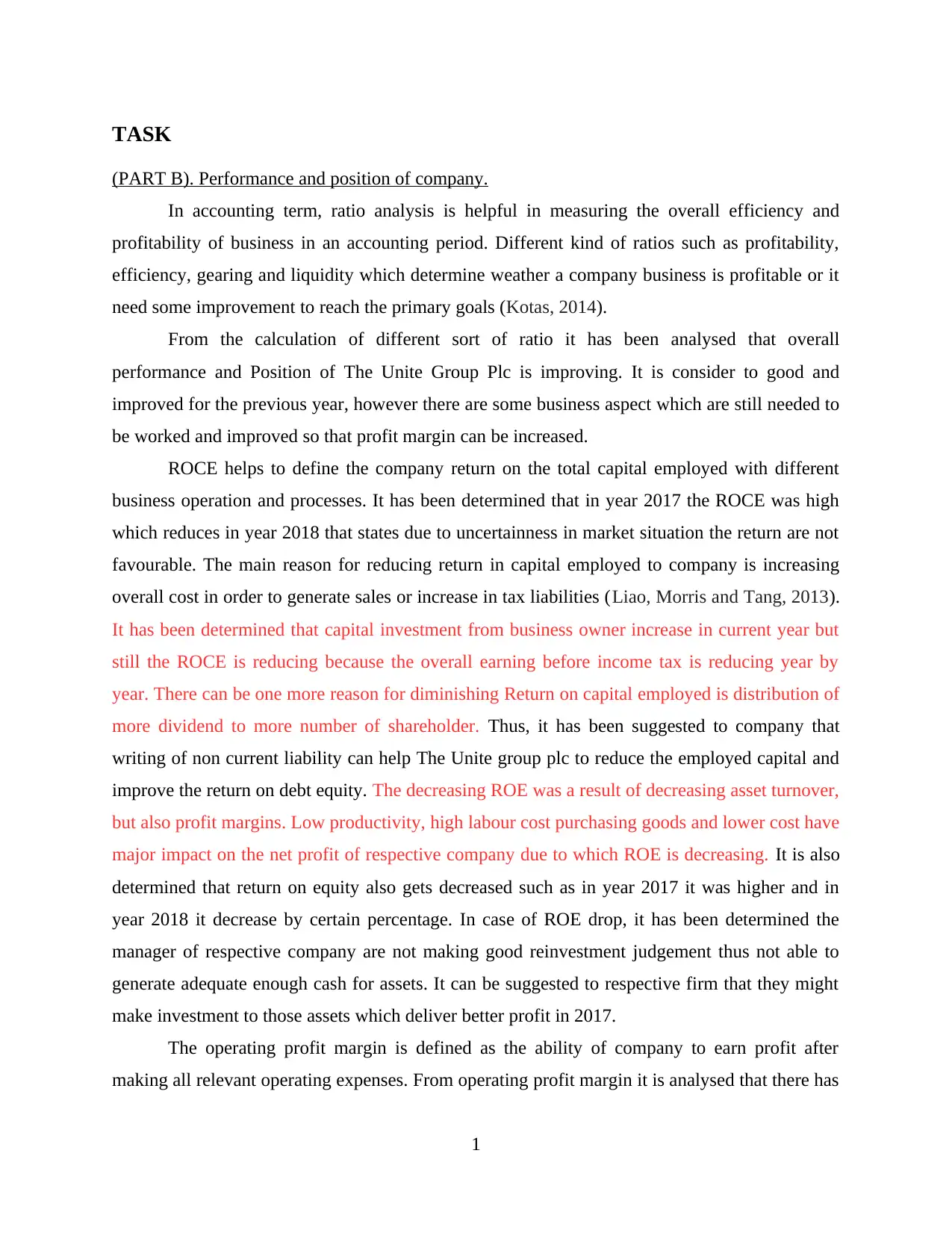
TASK
(PART B). Performance and position of company.
In accounting term, ratio analysis is helpful in measuring the overall efficiency and
profitability of business in an accounting period. Different kind of ratios such as profitability,
efficiency, gearing and liquidity which determine weather a company business is profitable or it
need some improvement to reach the primary goals (Kotas, 2014).
From the calculation of different sort of ratio it has been analysed that overall
performance and Position of The Unite Group Plc is improving. It is consider to good and
improved for the previous year, however there are some business aspect which are still needed to
be worked and improved so that profit margin can be increased.
ROCE helps to define the company return on the total capital employed with different
business operation and processes. It has been determined that in year 2017 the ROCE was high
which reduces in year 2018 that states due to uncertainness in market situation the return are not
favourable. The main reason for reducing return in capital employed to company is increasing
overall cost in order to generate sales or increase in tax liabilities (Liao, Morris and Tang, 2013).
It has been determined that capital investment from business owner increase in current year but
still the ROCE is reducing because the overall earning before income tax is reducing year by
year. There can be one more reason for diminishing Return on capital employed is distribution of
more dividend to more number of shareholder. Thus, it has been suggested to company that
writing of non current liability can help The Unite group plc to reduce the employed capital and
improve the return on debt equity. The decreasing ROE was a result of decreasing asset turnover,
but also profit margins. Low productivity, high labour cost purchasing goods and lower cost have
major impact on the net profit of respective company due to which ROE is decreasing. It is also
determined that return on equity also gets decreased such as in year 2017 it was higher and in
year 2018 it decrease by certain percentage. In case of ROE drop, it has been determined the
manager of respective company are not making good reinvestment judgement thus not able to
generate adequate enough cash for assets. It can be suggested to respective firm that they might
make investment to those assets which deliver better profit in 2017.
The operating profit margin is defined as the ability of company to earn profit after
making all relevant operating expenses. From operating profit margin it is analysed that there has
1
(PART B). Performance and position of company.
In accounting term, ratio analysis is helpful in measuring the overall efficiency and
profitability of business in an accounting period. Different kind of ratios such as profitability,
efficiency, gearing and liquidity which determine weather a company business is profitable or it
need some improvement to reach the primary goals (Kotas, 2014).
From the calculation of different sort of ratio it has been analysed that overall
performance and Position of The Unite Group Plc is improving. It is consider to good and
improved for the previous year, however there are some business aspect which are still needed to
be worked and improved so that profit margin can be increased.
ROCE helps to define the company return on the total capital employed with different
business operation and processes. It has been determined that in year 2017 the ROCE was high
which reduces in year 2018 that states due to uncertainness in market situation the return are not
favourable. The main reason for reducing return in capital employed to company is increasing
overall cost in order to generate sales or increase in tax liabilities (Liao, Morris and Tang, 2013).
It has been determined that capital investment from business owner increase in current year but
still the ROCE is reducing because the overall earning before income tax is reducing year by
year. There can be one more reason for diminishing Return on capital employed is distribution of
more dividend to more number of shareholder. Thus, it has been suggested to company that
writing of non current liability can help The Unite group plc to reduce the employed capital and
improve the return on debt equity. The decreasing ROE was a result of decreasing asset turnover,
but also profit margins. Low productivity, high labour cost purchasing goods and lower cost have
major impact on the net profit of respective company due to which ROE is decreasing. It is also
determined that return on equity also gets decreased such as in year 2017 it was higher and in
year 2018 it decrease by certain percentage. In case of ROE drop, it has been determined the
manager of respective company are not making good reinvestment judgement thus not able to
generate adequate enough cash for assets. It can be suggested to respective firm that they might
make investment to those assets which deliver better profit in 2017.
The operating profit margin is defined as the ability of company to earn profit after
making all relevant operating expenses. From operating profit margin it is analysed that there has
1
Secure Best Marks with AI Grader
Need help grading? Try our AI Grader for instant feedback on your assignments.
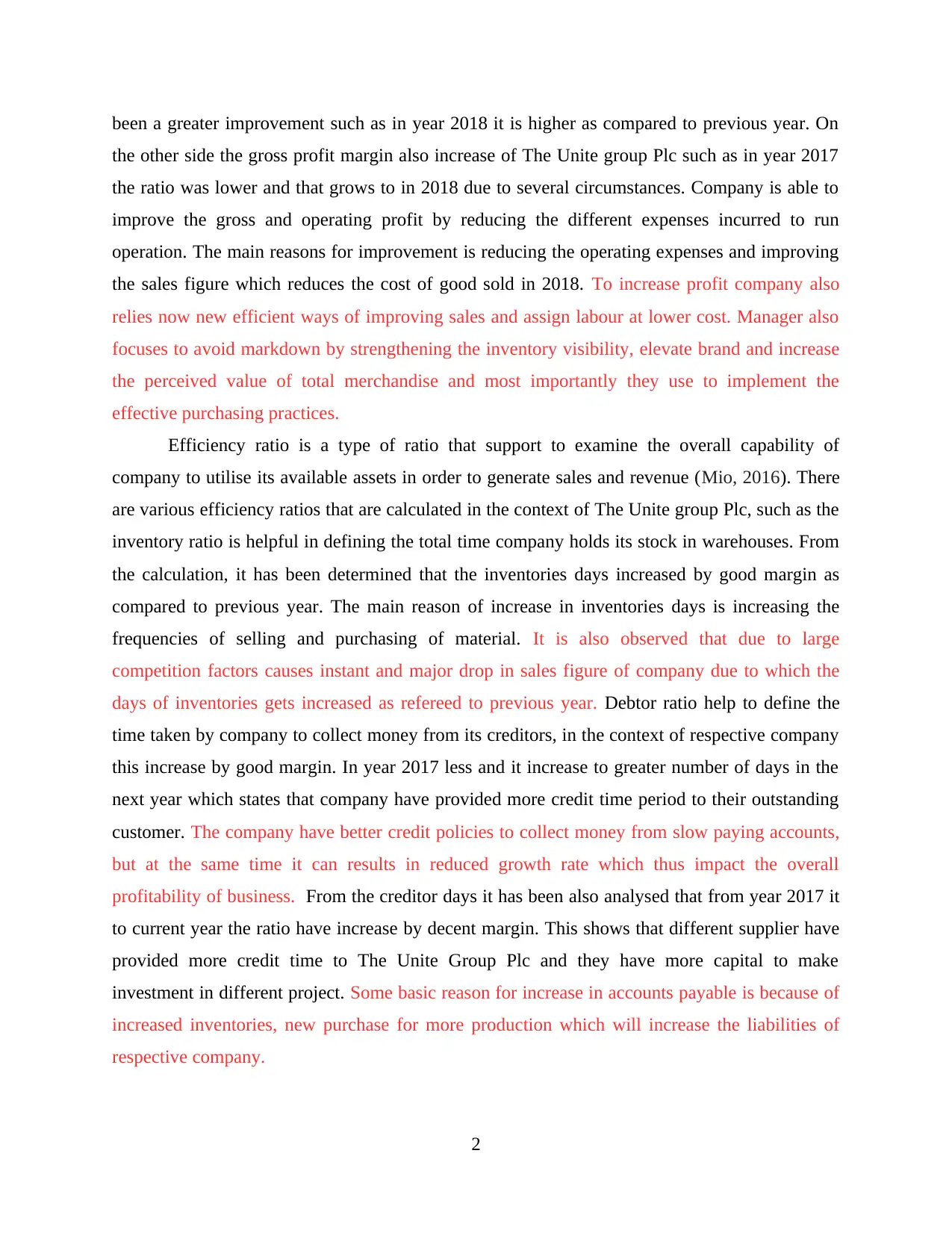
been a greater improvement such as in year 2018 it is higher as compared to previous year. On
the other side the gross profit margin also increase of The Unite group Plc such as in year 2017
the ratio was lower and that grows to in 2018 due to several circumstances. Company is able to
improve the gross and operating profit by reducing the different expenses incurred to run
operation. The main reasons for improvement is reducing the operating expenses and improving
the sales figure which reduces the cost of good sold in 2018. To increase profit company also
relies now new efficient ways of improving sales and assign labour at lower cost. Manager also
focuses to avoid markdown by strengthening the inventory visibility, elevate brand and increase
the perceived value of total merchandise and most importantly they use to implement the
effective purchasing practices.
Efficiency ratio is a type of ratio that support to examine the overall capability of
company to utilise its available assets in order to generate sales and revenue (Mio, 2016). There
are various efficiency ratios that are calculated in the context of The Unite group Plc, such as the
inventory ratio is helpful in defining the total time company holds its stock in warehouses. From
the calculation, it has been determined that the inventories days increased by good margin as
compared to previous year. The main reason of increase in inventories days is increasing the
frequencies of selling and purchasing of material. It is also observed that due to large
competition factors causes instant and major drop in sales figure of company due to which the
days of inventories gets increased as refereed to previous year. Debtor ratio help to define the
time taken by company to collect money from its creditors, in the context of respective company
this increase by good margin. In year 2017 less and it increase to greater number of days in the
next year which states that company have provided more credit time period to their outstanding
customer. The company have better credit policies to collect money from slow paying accounts,
but at the same time it can results in reduced growth rate which thus impact the overall
profitability of business. From the creditor days it has been also analysed that from year 2017 it
to current year the ratio have increase by decent margin. This shows that different supplier have
provided more credit time to The Unite Group Plc and they have more capital to make
investment in different project. Some basic reason for increase in accounts payable is because of
increased inventories, new purchase for more production which will increase the liabilities of
respective company.
2
the other side the gross profit margin also increase of The Unite group Plc such as in year 2017
the ratio was lower and that grows to in 2018 due to several circumstances. Company is able to
improve the gross and operating profit by reducing the different expenses incurred to run
operation. The main reasons for improvement is reducing the operating expenses and improving
the sales figure which reduces the cost of good sold in 2018. To increase profit company also
relies now new efficient ways of improving sales and assign labour at lower cost. Manager also
focuses to avoid markdown by strengthening the inventory visibility, elevate brand and increase
the perceived value of total merchandise and most importantly they use to implement the
effective purchasing practices.
Efficiency ratio is a type of ratio that support to examine the overall capability of
company to utilise its available assets in order to generate sales and revenue (Mio, 2016). There
are various efficiency ratios that are calculated in the context of The Unite group Plc, such as the
inventory ratio is helpful in defining the total time company holds its stock in warehouses. From
the calculation, it has been determined that the inventories days increased by good margin as
compared to previous year. The main reason of increase in inventories days is increasing the
frequencies of selling and purchasing of material. It is also observed that due to large
competition factors causes instant and major drop in sales figure of company due to which the
days of inventories gets increased as refereed to previous year. Debtor ratio help to define the
time taken by company to collect money from its creditors, in the context of respective company
this increase by good margin. In year 2017 less and it increase to greater number of days in the
next year which states that company have provided more credit time period to their outstanding
customer. The company have better credit policies to collect money from slow paying accounts,
but at the same time it can results in reduced growth rate which thus impact the overall
profitability of business. From the creditor days it has been also analysed that from year 2017 it
to current year the ratio have increase by decent margin. This shows that different supplier have
provided more credit time to The Unite Group Plc and they have more capital to make
investment in different project. Some basic reason for increase in accounts payable is because of
increased inventories, new purchase for more production which will increase the liabilities of
respective company.
2
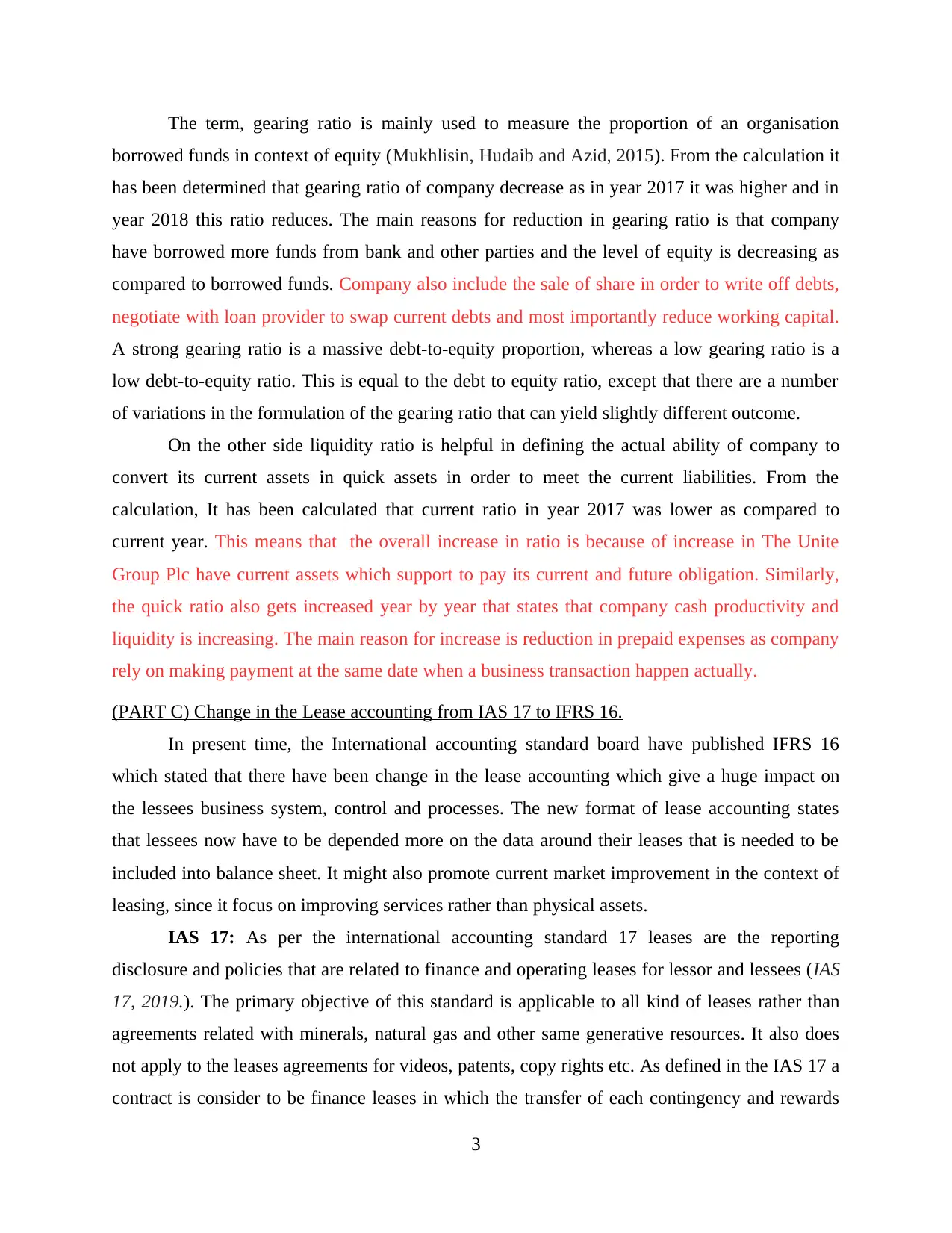
The term, gearing ratio is mainly used to measure the proportion of an organisation
borrowed funds in context of equity (Mukhlisin, Hudaib and Azid, 2015). From the calculation it
has been determined that gearing ratio of company decrease as in year 2017 it was higher and in
year 2018 this ratio reduces. The main reasons for reduction in gearing ratio is that company
have borrowed more funds from bank and other parties and the level of equity is decreasing as
compared to borrowed funds. Company also include the sale of share in order to write off debts,
negotiate with loan provider to swap current debts and most importantly reduce working capital.
A strong gearing ratio is a massive debt-to-equity proportion, whereas a low gearing ratio is a
low debt-to-equity ratio. This is equal to the debt to equity ratio, except that there are a number
of variations in the formulation of the gearing ratio that can yield slightly different outcome.
On the other side liquidity ratio is helpful in defining the actual ability of company to
convert its current assets in quick assets in order to meet the current liabilities. From the
calculation, It has been calculated that current ratio in year 2017 was lower as compared to
current year. This means that the overall increase in ratio is because of increase in The Unite
Group Plc have current assets which support to pay its current and future obligation. Similarly,
the quick ratio also gets increased year by year that states that company cash productivity and
liquidity is increasing. The main reason for increase is reduction in prepaid expenses as company
rely on making payment at the same date when a business transaction happen actually.
(PART C) Change in the Lease accounting from IAS 17 to IFRS 16.
In present time, the International accounting standard board have published IFRS 16
which stated that there have been change in the lease accounting which give a huge impact on
the lessees business system, control and processes. The new format of lease accounting states
that lessees now have to be depended more on the data around their leases that is needed to be
included into balance sheet. It might also promote current market improvement in the context of
leasing, since it focus on improving services rather than physical assets.
IAS 17: As per the international accounting standard 17 leases are the reporting
disclosure and policies that are related to finance and operating leases for lessor and lessees (IAS
17, 2019.). The primary objective of this standard is applicable to all kind of leases rather than
agreements related with minerals, natural gas and other same generative resources. It also does
not apply to the leases agreements for videos, patents, copy rights etc. As defined in the IAS 17 a
contract is consider to be finance leases in which the transfer of each contingency and rewards
3
borrowed funds in context of equity (Mukhlisin, Hudaib and Azid, 2015). From the calculation it
has been determined that gearing ratio of company decrease as in year 2017 it was higher and in
year 2018 this ratio reduces. The main reasons for reduction in gearing ratio is that company
have borrowed more funds from bank and other parties and the level of equity is decreasing as
compared to borrowed funds. Company also include the sale of share in order to write off debts,
negotiate with loan provider to swap current debts and most importantly reduce working capital.
A strong gearing ratio is a massive debt-to-equity proportion, whereas a low gearing ratio is a
low debt-to-equity ratio. This is equal to the debt to equity ratio, except that there are a number
of variations in the formulation of the gearing ratio that can yield slightly different outcome.
On the other side liquidity ratio is helpful in defining the actual ability of company to
convert its current assets in quick assets in order to meet the current liabilities. From the
calculation, It has been calculated that current ratio in year 2017 was lower as compared to
current year. This means that the overall increase in ratio is because of increase in The Unite
Group Plc have current assets which support to pay its current and future obligation. Similarly,
the quick ratio also gets increased year by year that states that company cash productivity and
liquidity is increasing. The main reason for increase is reduction in prepaid expenses as company
rely on making payment at the same date when a business transaction happen actually.
(PART C) Change in the Lease accounting from IAS 17 to IFRS 16.
In present time, the International accounting standard board have published IFRS 16
which stated that there have been change in the lease accounting which give a huge impact on
the lessees business system, control and processes. The new format of lease accounting states
that lessees now have to be depended more on the data around their leases that is needed to be
included into balance sheet. It might also promote current market improvement in the context of
leasing, since it focus on improving services rather than physical assets.
IAS 17: As per the international accounting standard 17 leases are the reporting
disclosure and policies that are related to finance and operating leases for lessor and lessees (IAS
17, 2019.). The primary objective of this standard is applicable to all kind of leases rather than
agreements related with minerals, natural gas and other same generative resources. It also does
not apply to the leases agreements for videos, patents, copy rights etc. As defined in the IAS 17 a
contract is consider to be finance leases in which the transfer of each contingency and rewards
3
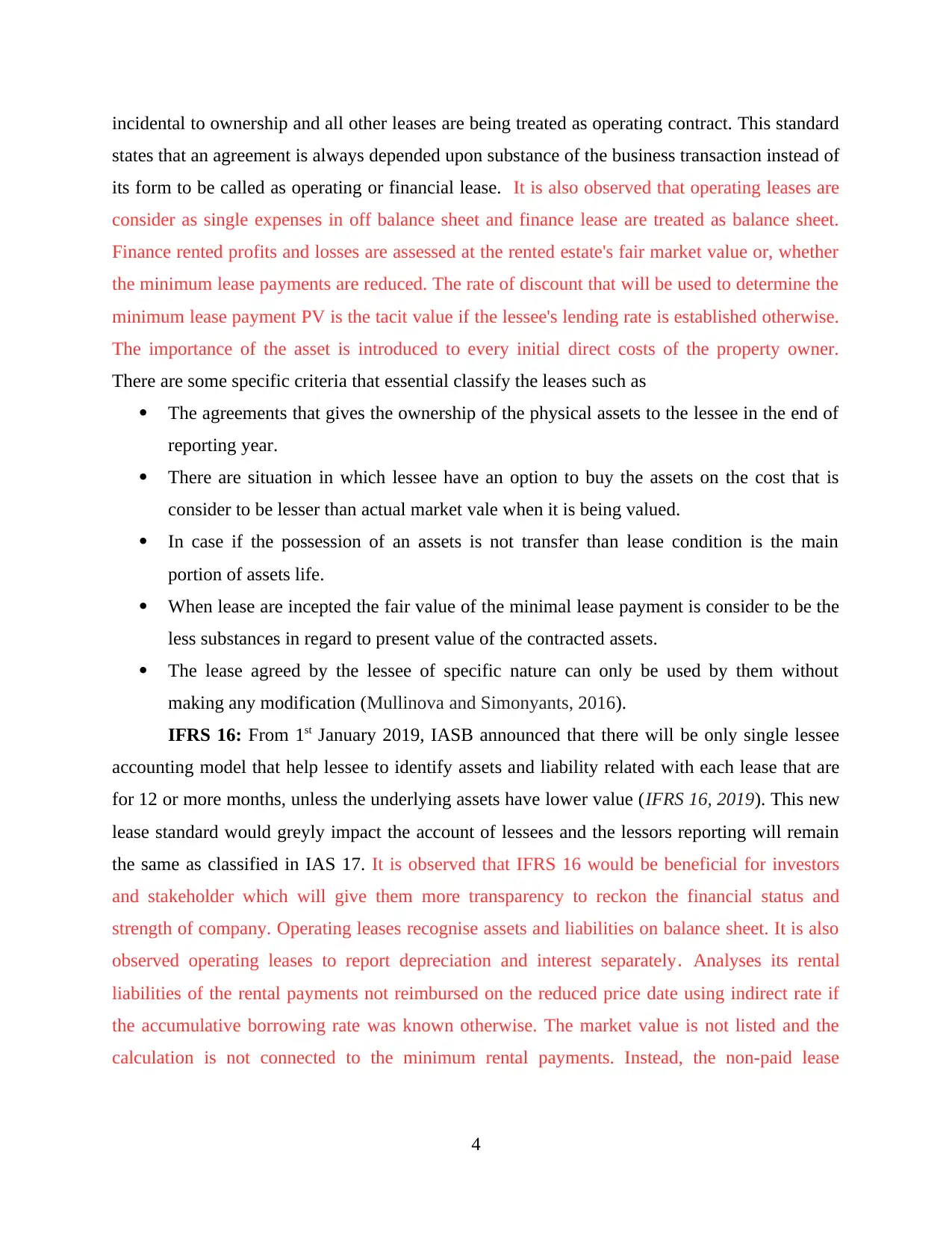
incidental to ownership and all other leases are being treated as operating contract. This standard
states that an agreement is always depended upon substance of the business transaction instead of
its form to be called as operating or financial lease. It is also observed that operating leases are
consider as single expenses in off balance sheet and finance lease are treated as balance sheet.
Finance rented profits and losses are assessed at the rented estate's fair market value or, whether
the minimum lease payments are reduced. The rate of discount that will be used to determine the
minimum lease payment PV is the tacit value if the lessee's lending rate is established otherwise.
The importance of the asset is introduced to every initial direct costs of the property owner.
There are some specific criteria that essential classify the leases such as
The agreements that gives the ownership of the physical assets to the lessee in the end of
reporting year.
There are situation in which lessee have an option to buy the assets on the cost that is
consider to be lesser than actual market vale when it is being valued.
In case if the possession of an assets is not transfer than lease condition is the main
portion of assets life.
When lease are incepted the fair value of the minimal lease payment is consider to be the
less substances in regard to present value of the contracted assets.
The lease agreed by the lessee of specific nature can only be used by them without
making any modification (Mullinova and Simonyants, 2016).
IFRS 16: From 1st January 2019, IASB announced that there will be only single lessee
accounting model that help lessee to identify assets and liability related with each lease that are
for 12 or more months, unless the underlying assets have lower value (IFRS 16, 2019). This new
lease standard would greyly impact the account of lessees and the lessors reporting will remain
the same as classified in IAS 17. It is observed that IFRS 16 would be beneficial for investors
and stakeholder which will give them more transparency to reckon the financial status and
strength of company. Operating leases recognise assets and liabilities on balance sheet. It is also
observed operating leases to report depreciation and interest separately. Analyses its rental
liabilities of the rental payments not reimbursed on the reduced price date using indirect rate if
the accumulative borrowing rate was known otherwise. The market value is not listed and the
calculation is not connected to the minimum rental payments. Instead, the non-paid lease
4
states that an agreement is always depended upon substance of the business transaction instead of
its form to be called as operating or financial lease. It is also observed that operating leases are
consider as single expenses in off balance sheet and finance lease are treated as balance sheet.
Finance rented profits and losses are assessed at the rented estate's fair market value or, whether
the minimum lease payments are reduced. The rate of discount that will be used to determine the
minimum lease payment PV is the tacit value if the lessee's lending rate is established otherwise.
The importance of the asset is introduced to every initial direct costs of the property owner.
There are some specific criteria that essential classify the leases such as
The agreements that gives the ownership of the physical assets to the lessee in the end of
reporting year.
There are situation in which lessee have an option to buy the assets on the cost that is
consider to be lesser than actual market vale when it is being valued.
In case if the possession of an assets is not transfer than lease condition is the main
portion of assets life.
When lease are incepted the fair value of the minimal lease payment is consider to be the
less substances in regard to present value of the contracted assets.
The lease agreed by the lessee of specific nature can only be used by them without
making any modification (Mullinova and Simonyants, 2016).
IFRS 16: From 1st January 2019, IASB announced that there will be only single lessee
accounting model that help lessee to identify assets and liability related with each lease that are
for 12 or more months, unless the underlying assets have lower value (IFRS 16, 2019). This new
lease standard would greyly impact the account of lessees and the lessors reporting will remain
the same as classified in IAS 17. It is observed that IFRS 16 would be beneficial for investors
and stakeholder which will give them more transparency to reckon the financial status and
strength of company. Operating leases recognise assets and liabilities on balance sheet. It is also
observed operating leases to report depreciation and interest separately. Analyses its rental
liabilities of the rental payments not reimbursed on the reduced price date using indirect rate if
the accumulative borrowing rate was known otherwise. The market value is not listed and the
calculation is not connected to the minimum rental payments. Instead, the non-paid lease
4
Paraphrase This Document
Need a fresh take? Get an instant paraphrase of this document with our AI Paraphraser

payments. There are some respective transaction provision which mainly replace the IAS 17
from 1st Jan 2019 such as:
All current financing agreements are continued to be treat as a finance leases.
While all operating leases will have an option to fully of partially implement the new
standard and show them in the financial statements (Rupley, Brown and Marshall, 2017).
In the context of company, the implementation of new reporting for lease does nor impact
the company financial position in relevance to make cash payments, that are mainly recognised
by the lender. It is also assumed that IFRS 16 would let to facilitate and improve allocation of
capital by developing more and more investment and credit facilities by both business entity and
investors. There are some major benefit of new accounting standard to lessee and lessors some of
these are mention below:
Lessees:
The price related with implementing and complying of the new leases is regarded as
crucial for most of the leaseholder, in case if they don't have a specific in house lease
information system.
Companies leasing bigger assets such as real estate, aircraft, ships and advance technical
devices are anticipated to get impacted largely. On the other side, it is defined that low
worth assets below $5000 are not require to show this transaction on the annual balance
sheet.
Lessor:
For all the current and upcoming contract the lessors and lessees are not required to
restructure the accounting reports.
It is also stated that accounting for lessor will be the same as mentioned in IAS 17, but in
some case the lessor gets affected because of the changes in the nature of customer to buy
good and services (Rupley, Brown and Marshall, 2017.).
From the balance sheet of The Unite Group PLC the operating lease rental comes from
the assets that the company have sold out and is preparing to lease back. In 2018 the total rental
income of £M 18.6 and property operating expenses of £M7.0 are related with sale and leaseback
properties. On the other side, in 2017 the rental income of £18.6 million and property operating
expenses of £7.0 million relating to sale and leaseback properties. The total operating expenses
5
from 1st Jan 2019 such as:
All current financing agreements are continued to be treat as a finance leases.
While all operating leases will have an option to fully of partially implement the new
standard and show them in the financial statements (Rupley, Brown and Marshall, 2017).
In the context of company, the implementation of new reporting for lease does nor impact
the company financial position in relevance to make cash payments, that are mainly recognised
by the lender. It is also assumed that IFRS 16 would let to facilitate and improve allocation of
capital by developing more and more investment and credit facilities by both business entity and
investors. There are some major benefit of new accounting standard to lessee and lessors some of
these are mention below:
Lessees:
The price related with implementing and complying of the new leases is regarded as
crucial for most of the leaseholder, in case if they don't have a specific in house lease
information system.
Companies leasing bigger assets such as real estate, aircraft, ships and advance technical
devices are anticipated to get impacted largely. On the other side, it is defined that low
worth assets below $5000 are not require to show this transaction on the annual balance
sheet.
Lessor:
For all the current and upcoming contract the lessors and lessees are not required to
restructure the accounting reports.
It is also stated that accounting for lessor will be the same as mentioned in IAS 17, but in
some case the lessor gets affected because of the changes in the nature of customer to buy
good and services (Rupley, Brown and Marshall, 2017.).
From the balance sheet of The Unite Group PLC the operating lease rental comes from
the assets that the company have sold out and is preparing to lease back. In 2018 the total rental
income of £M 18.6 and property operating expenses of £M7.0 are related with sale and leaseback
properties. On the other side, in 2017 the rental income of £18.6 million and property operating
expenses of £7.0 million relating to sale and leaseback properties. The total operating expenses
5
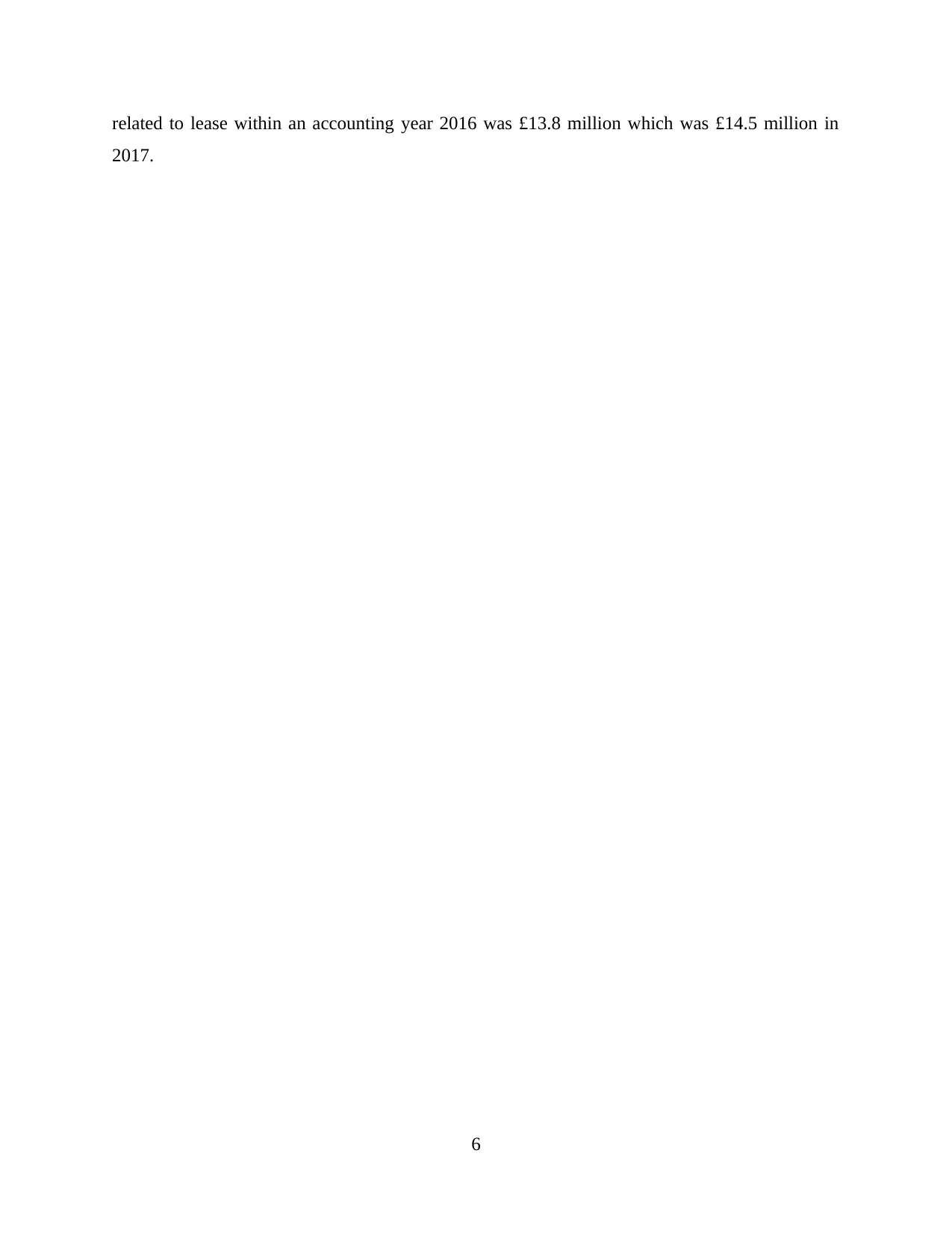
related to lease within an accounting year 2016 was £13.8 million which was £14.5 million in
2017.
6
2017.
6
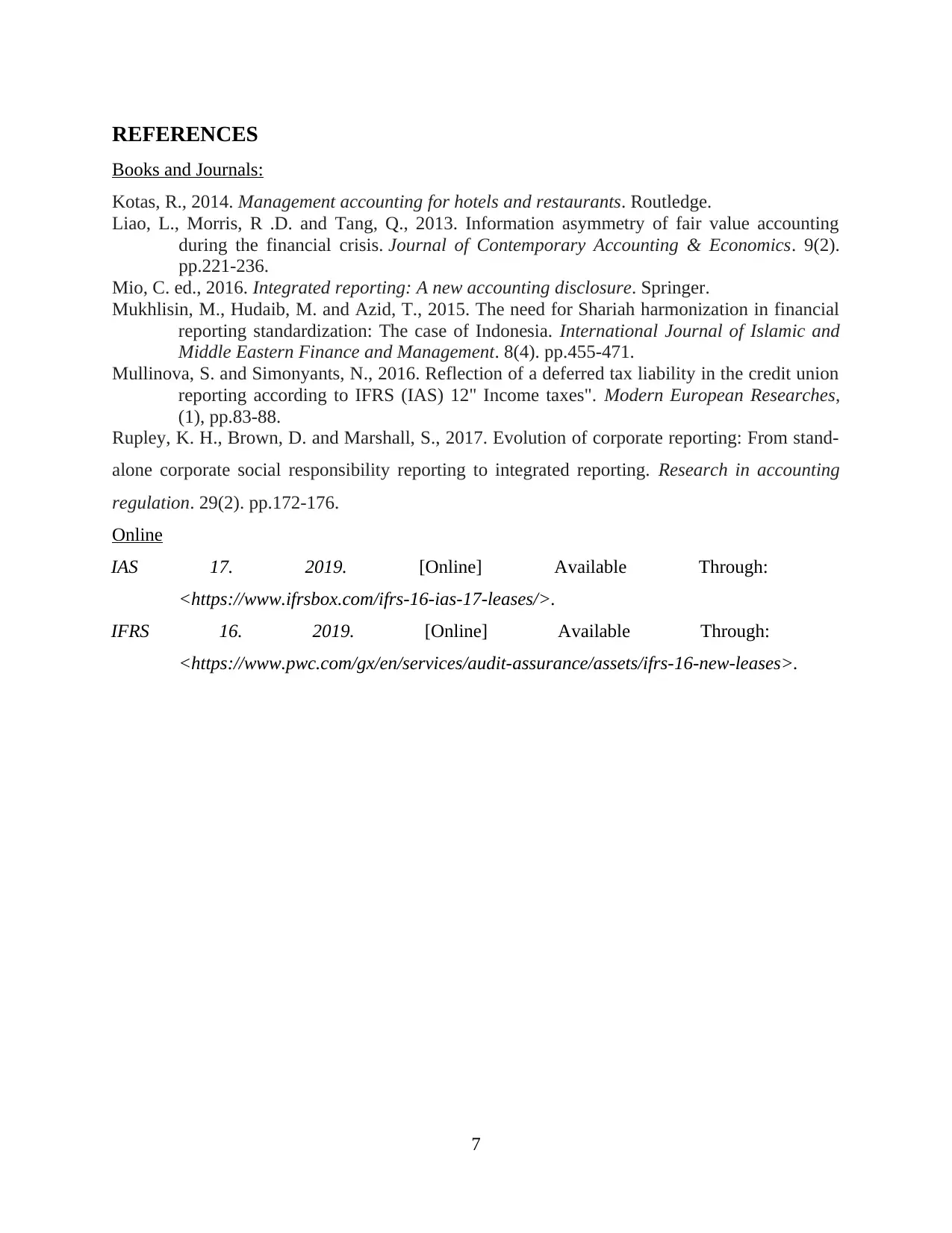
REFERENCES
Books and Journals:
Kotas, R., 2014. Management accounting for hotels and restaurants. Routledge.
Liao, L., Morris, R .D. and Tang, Q., 2013. Information asymmetry of fair value accounting
during the financial crisis. Journal of Contemporary Accounting & Economics. 9(2).
pp.221-236.
Mio, C. ed., 2016. Integrated reporting: A new accounting disclosure. Springer.
Mukhlisin, M., Hudaib, M. and Azid, T., 2015. The need for Shariah harmonization in financial
reporting standardization: The case of Indonesia. International Journal of Islamic and
Middle Eastern Finance and Management. 8(4). pp.455-471.
Mullinova, S. and Simonyants, N., 2016. Reflection of a deferred tax liability in the credit union
reporting according to IFRS (IAS) 12" Income taxes". Modern European Researches,
(1), pp.83-88.
Rupley, K. H., Brown, D. and Marshall, S., 2017. Evolution of corporate reporting: From stand-
alone corporate social responsibility reporting to integrated reporting. Research in accounting
regulation. 29(2). pp.172-176.
Online
IAS 17. 2019. [Online] Available Through:
<https://www.ifrsbox.com/ifrs-16-ias-17-leases/>.
IFRS 16. 2019. [Online] Available Through:
<https://www.pwc.com/gx/en/services/audit-assurance/assets/ifrs-16-new-leases>.
7
Books and Journals:
Kotas, R., 2014. Management accounting for hotels and restaurants. Routledge.
Liao, L., Morris, R .D. and Tang, Q., 2013. Information asymmetry of fair value accounting
during the financial crisis. Journal of Contemporary Accounting & Economics. 9(2).
pp.221-236.
Mio, C. ed., 2016. Integrated reporting: A new accounting disclosure. Springer.
Mukhlisin, M., Hudaib, M. and Azid, T., 2015. The need for Shariah harmonization in financial
reporting standardization: The case of Indonesia. International Journal of Islamic and
Middle Eastern Finance and Management. 8(4). pp.455-471.
Mullinova, S. and Simonyants, N., 2016. Reflection of a deferred tax liability in the credit union
reporting according to IFRS (IAS) 12" Income taxes". Modern European Researches,
(1), pp.83-88.
Rupley, K. H., Brown, D. and Marshall, S., 2017. Evolution of corporate reporting: From stand-
alone corporate social responsibility reporting to integrated reporting. Research in accounting
regulation. 29(2). pp.172-176.
Online
IAS 17. 2019. [Online] Available Through:
<https://www.ifrsbox.com/ifrs-16-ias-17-leases/>.
IFRS 16. 2019. [Online] Available Through:
<https://www.pwc.com/gx/en/services/audit-assurance/assets/ifrs-16-new-leases>.
7
1 out of 10
Related Documents
Your All-in-One AI-Powered Toolkit for Academic Success.
+13062052269
info@desklib.com
Available 24*7 on WhatsApp / Email
![[object Object]](/_next/static/media/star-bottom.7253800d.svg)
Unlock your academic potential
© 2024 | Zucol Services PVT LTD | All rights reserved.





